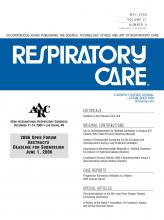Abstract
Patient-advocacy organizations have proliferated because they can be an effective method to advance research and clinical care for those with the index condition, and can produce substantial benefits for the affected community, especially when the condition is uncommon. To clarify critical success factors in organizing a patient-advocacy organization and to provide a blueprint for others, including the respiratory-care advocacy community, this report examines features of one highly successful organization, the Alpha-1 Foundation, which is committed to helping those with the genetic condition alpha-1 antitrypsin deficiency. Features of the Alpha-1 Foundation that underlie its success include: consistently creating partnerships with key stakeholders, including the scientific and clinical communities, government, and pharmaceutical manufacturers; bringing passion to the cause (eg, by assuring that organizational leadership is provided by individuals affected by alpha-1 antitrypsin deficiency); and developing strategic business partnerships, as with a company that administers alpha-1 antitrypsin treatment (so-called intravenous augmentation therapy) and employs individuals with alpha-1 antitrypsin deficiency. Funds allocated by the company help to underwrite the foundation's research-funding commitment. The foundation also recruits and retains talent, including alpha-1 patients, to leadership roles (eg, on the board of directors) and has a voluntary group of committed scientists and clinicians. We believe that attention to these factors can help assure the success of patient-advocacy groups.
Footnotes
- Correspondence: James K Stoller MD MSc FAARC, Department of Pulmonary and Critical Care Medicine, A90, The Cleveland Clinic Foundation, 9500 Euclid Avenue, Cleveland OH 44195. E-mail: stollej{at}ccf.org.
- Copyright © 2006 by Daedalus Enterprises Inc.







